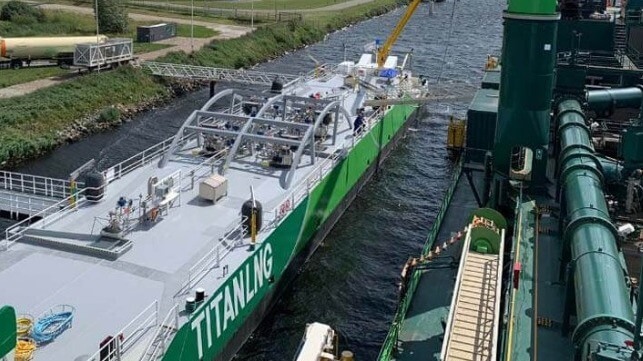BioLNG Production is Scaling Up Today

Production of bioLNG is already scaling up, it fits into the circular economy and there is enough feedstock available right now. Local production and diverse feedstocks can also improve energy security, for example in the European Union (EU). Meanwhile, suppliers, shipowners, ship operators and everyone else in the value chain can continue using existing LNG assets and infrastructure. Caspar Gooren, Carbon Zero Director at Titan LNG, explains why bioLNG is the clear next step along the pathway to maritime decarbonization.
BioLNG production
BioLNG is biogas that has been liquified and therefore can be used as a sustainable marine fuel. Biogas is produced when organic waste and residues ferment and anaerobic digestion occurs. This can be achieved on a commercial scale by putting biomass into a digester to produce biomethane plus bioCO2. This biomethane is then liquified into usable bioLNG. The feedstock for this bioLNG is predominantly domestic and agricultural waste, for example household waste, sewage sledge and manure.
By using waste feedstock, bioLNG production can capture methane that would otherwise be released into the atmosphere. Therefore, the outcome is a fuel that is potentially net-negative in greenhouse gas (GHG) emissions, not just net-zero. By assisting with the recycling of waste, bioLNG production also aids in waste management and supports the circular economic model that most environmentalists and economists agree is critical to combating environmental degradation.
There is more than enough of this feedstock available to scale up bioLNG production and meet the shipping industry’s needs. Especially as some biogas is currently burned in co-generation and fed into the electricity grid, which is not the optimal way of using this energy as power can efficiently be generated from other renewable sources.
Take the EU as an example; its total biogas availability is close to 170 terawatt hours. If this was all converted into bioLNG it would make 11 million tonnes. Today, more than enough biogas could be supplied to the shipping industry as bioLNG using EU feedstock alone.
Energy security
Titan LNG has already started work on multiple bioLNG production and off-take projects. For example the FirstBio2Shipping project – a collaboration between Titan, Attero, and Nordsol – has received $4.5 million in EU funding. The plant, located at the Attero facility in Wilp, the Netherlands, will produce around 2,400 tonnes per year of bioLNG, with the first fuel set to be produced as early as 2023.
The potential to produce bioLNG locally, as demonstrated by the FirstBio2Shipping project, can also improve energy security. When producing bioLNG, governments do not rely on the scarce resources of neighboring nations, but rather can produce their own energy using waste feedstocks that are available and abundant. This production can even be decentralized, which decouples energy production from national security.
The feedstocks from bioLNG are also diverse. Livestock waste, landfill gas (LFG), activated sludge from wastewater treatment plants, and industrial, institutional and commercial waste (IIC) are all options. This diversity further improves energy security by reducing reliance on one particular resource and minimizing exposure to the price fluctuation of that specific resource.
Marine fuel
Safety is a major benefit of using LNG, and its derivates, which is often taken for granted by shipping’s stakeholders. According to DNV, LNG removes up to 80 percent of nitrogen oxides (NOx) from the air and almost eliminates sulphur oxides (SOx) and particulate matter (PM) emissions. This immediately has a positive impact on local air quality and seafarer’s working conditions. Seafarers also have extensive experience of safely working with LNG. Many of these practices apply to handling bioLNG and hydrogen-derived LNG too, while alternatives to LNG still have major safety concerns that must be addressed, including toxicity and flammability.
The maritime industry is well-versed in the other practical benefits of using bioLNG as a marine fuel. Particularly, the ability to drop bioLNG into existing LNG-fueled vessels and bunkering infrastructure, and to blend bioLNG with traditional LNG or hydrogen-derived LNG at any ratio.
However, these capabilities point to a broader benefit which is often overlooked. LNG gives shipowners and operators options. They can choose LNG to tackle emissions right now, and then transition to bioLNG to further reduce emissions as production continues to scale up and become more efficient – all without having to adapt infrastructure. They can then switch to hydrogen-derived LNG, produced using renewable energy, once it becomes available – still using the same infrastructure.
Engine manufacturers are currently creating LNG dual-fuel engines that can use many of the alternative marine fuels being debated, including bioLNG and hydrogen-derived LNG. This is yet more evidence that investments in LNG infrastructure and LNG-fueled vessels are future proof, regardless of whether technologies change or not. Whatever happens in the future, with LNG, shipowners and operators have a clear long-term pathway to the full decarbonization of their vessels, while reducing emissions right now, adhering to regulations, and offering an advantage within carbon markets.
For example, as a key part of the EU’s ‘Fit for 55’ package paving the way to climate neutrality in Europe by 2050, the Emissions Trading System (ETS) will be key in influencing fuel choice. LNG will give ship operators competitive advantage over those using oil-based marine fuels within the EU’s ETS, while bioLNG goes a step further and can provide long-term competitive advantage over even traditional LNG. The benefits of using bioLNG within the ETS should not be overlooked.
Caspar Gooren is Carbon Zero Director at Titan LNG, a leading, independent, physical supplier of commercially available alternative fuels such as LNG and bioLNG to industrial customers, truck fueling stations and the marine sector.
The opinions expressed herein are the author's and not necessarily those of The Maritime Executive.

